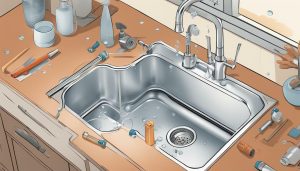If your kitchen sink is looking worn out or damaged, it may be time for a replacement. While you may be hesitant to take on a project like this, it is actually easier than you think! In this guide, we will walk you through the steps to replace your kitchen sink on your own.
Key Takeaways:
- Replacing a worn-out kitchen sink is a manageable DIY project.
- Assess the condition of your current sink to determine if it needs to be replaced.
- Gather the necessary tools and materials before beginning the project.
- Properly remove the old sink before installing the new one.
- Test and adjust the new sink for proper functionality.
- Maintain and care for your new sink to ensure its longevity.
Assessing the Condition of Your Kitchen Sink
Before embarking on a kitchen sink replacement project, it is important to assess the condition of your current sink. There are a few signs that indicate it may be time to replace your kitchen sink. If your sink is leaking, damaged, or has a significant amount of rust or corrosion, it may be time for a new one.
Replacing a kitchen sink can be a DIY project that can save you time and money. By doing it yourself, you can ensure that the new sink is installed correctly and meets your exact specifications. As you assess the condition of your sink, consider the benefits of a DIY kitchen sink replacement.
Signs it’s Time to Replace Your Kitchen Sink
There are several indicators that your kitchen sink needs to be replaced. These include:
- Leaks
- Cracks and damages
- Rust and corrosion
- Stains that can’t be removed
- An outdated or unattractive appearance
If you notice any of these signs, it may be time to replace your kitchen sink. Doing so can improve the functionality and appearance of your kitchen.
Gathering the Necessary Tools and Materials
Before starting your step-by-step kitchen sink replacement project, it’s essential to gather all the necessary tools and materials to ensure a smooth installation process. Make sure to have the following items on-hand:
| Tools | Materials |
|---|---|
| Adjustable wrench | New kitchen sink |
| Bucket | Sink clips |
| Channel locks | Silicone sealant |
| Putty knife | Plumber’s putty |
| Hacksaw or reciprocating saw | New drain and tailpiece assembly |
| Screwdriver | Teflon tape |
| Plumbers tape | New supply lines |
| Safety goggles |
Make sure to have all necessary tools and materials before starting your kitchen sink installation project. This will save you time and prevent any interruptions during the installation.
Removing the Old Kitchen Sink
Before starting the removal process, turn off the water supply to the sink and disconnect the drain and water lines. Make sure you have a bucket or towels ready to catch any excess water.
Next, use a utility knife or putty knife to cut through any caulk or adhesive connecting the sink to the countertop. Slowly and carefully loosen the sink from the countertop, being mindful of any clips or brackets holding it in place.
Once the sink is free, lift it out and set it aside. Inspect the area for any damage or wear and tear that may need to be addressed before installing the new sink.
Removing a Garbage Disposal
If your kitchen sink has a garbage disposal, you will need to disconnect it before removing the sink. Start by turning off the power to the unit and unhooking the electrical connection.
Next, use a screwdriver to loosen the mounting screws that attach the disposal to the sink. Remove the disposal, and then proceed with removing the sink as outlined above.
Keep in mind that if you are not comfortable working with electrical or plumbing connections, it may be best to consult a professional for assistance.
Preparing for the New Kitchen Sink Installation:
Before installing the new kitchen sink, it is essential to prepare the area and ensure that everything is in order. Here are the necessary steps:
- Measure the opening of the sink: Place the new sink upside down on the countertop and measure the distance between the outer edges to ensure it fits in the opening. If the sink is too big, you may need to make adjustments to the countertop.
- Inspect the plumbing: Check the condition of the pipes and connections to make sure they are in good condition. If you notice any damage or wear, replace them before proceeding.
- Clean the area: Remove any debris or old caulk from the countertop and sink opening. Use a scraper or putty knife to ensure the area is clean and flat.
- Get the necessary materials: Gather all the tools and materials you need for the installation, including a screwdriver, adjustable wrench, plumber’s putty, silicone caulk, and a hacksaw.
By following these steps, you will be better prepared for a successful kitchen sink installation and ensure that the process runs smoothly. With a little preparation and attention to detail, replacing a damaged kitchen sink can be a DIY project that saves you both time and money.
Installing the New Kitchen Sink
Now that you’ve successfully removed the old kitchen sink, it’s time to install the new one. Follow these step-by-step instructions for a smooth and successful installation.
Step 1: Prepare the area
Before installing the new sink, make sure the area is clean and free of debris. Place a towel or cardboard box in the sink base to prevent any damage during installation.
Step 2: Install the Faucet and Drain
Install the faucet and drain onto the sink before placing it into the countertop. Follow the manufacturer’s instructions and make sure all the necessary parts are securely in place.
Step 3: Place the Sink into Position
With the help of a friend or family member, carefully place the new sink into position. Ensure that it is level and centered before proceeding.
Step 4: Secure the Sink in Place
Secure the sink in place using clips or mounting brackets that came with the sink. Make sure it is tight and secure.
Step 5: Connect the plumbing
Connect the plumbing to the sink and faucet, following the manufacturer’s instructions. If necessary, use plumber’s tape to ensure a secure connection.
Step 6: Check for Leaks
Turn on the water and check for leaks. If any issues arise, immediately shut off the water and make any necessary adjustments.
Congratulations! You have now successfully installed your new kitchen sink.
Testing and Adjusting the New Kitchen Sink
Now that you’ve installed your new kitchen sink, it’s important to test it for leaks and make any necessary adjustments before finalizing the project.
Begin by checking all of the connections and joints to ensure they are tight and secure. Turn on the water supply and let the water run for a few minutes. Keep an eye out for any leaks or drips. If you notice any leaks, turn off the water supply and tighten the connections until the leaks stop.
Next, test the drain by filling the sink with water and letting it drain out completely. Again, check for any leaks or drips in the drain system and make any necessary adjustments.
If everything appears to be working properly, it’s time to make any final adjustments. Check the alignment of the sink to ensure it is level and flush with the countertop. If needed, adjust the sink’s position before securing it in place.
Once all adjustments have been made, turn on the water supply and test the sink again. Congratulations, you have successfully installed a new kitchen sink!
Cleaning Up and Finishing Touches
Once the new kitchen sink has been successfully installed, it’s time to clean up and add some finishing touches. This will ensure that the kitchen sink looks great and functions properly. Follow these tips for a successful DIY kitchen sink replacement.
Clean Up: First, remove any debris and materials left from the old sink. Use a putty knife to scrape off any remaining caulk or adhesive. Use a cleaning solution to thoroughly clean the sink, the countertop, and the surrounding area. Make sure to dry everything completely before moving onto the next step.
Sealing: Before installing the new kitchen sink, apply a bead of silicone caulk around the perimeter of the opening in the countertop. This will help prevent water from seeping beneath the sink and causing damage. Make sure to smooth out the caulk with your finger or a caulk smoothing tool for a clean, professional look.
Mounting Clips: If your new kitchen sink includes mounting clips, use them to secure the sink in place. Tighten the clips gently to avoid damaging the sink or the countertop. If the sink doesn’t have mounting clips, use silicone adhesive to secure it to the countertop.
Drain and Water Connections: Reconnect the drain and water connections to the new kitchen sink. Make sure all connections are tight and leak-free. Turn on the water supply and check for any leaks.
Final Touches: Once everything is in place and working properly, apply a final bead of silicone caulk around the edges of the sink to create a watertight seal. Use a caulk smoothing tool to create a clean, finished look. Wipe away any excess caulk with a damp cloth.
By following these steps, you can successfully complete a kitchen sink installation, giving your kitchen a fresh, updated look. With a little bit of patience and effort, you can save money and have a great sense of accomplishment.
Maintenance and Care for Your New Kitchen Sink
Now that you’ve successfully completed your DIY kitchen sink replacement and have a shiny new sink, it’s important to know how to properly maintain and care for it to ensure its longevity. Here are some tips:
- Regularly clean your sink with a mild cleaner and a soft cloth or sponge to avoid scratches and discoloration. Avoid using abrasive pads or harsh chemicals, as they can damage the surface of the sink.
- Don’t leave standing water in the sink for an extended period of time, as it can cause discoloration and may lead to unpleasant odors.
- To prevent clogs, avoid pouring grease or oil down the drain. Instead, dispose of them in a separate container or wipe away excess with a paper towel before washing dishes.
- If you notice any chips or scratches on the surface of the sink, address them as soon as possible by filling them in with a sink repair kit or contacting a professional for repairs.
- Periodically check the sink’s plumbing connections for leaks or other issues. Tighten any loose connections or replace damaged parts as necessary.
By following these simple steps, you can keep your new kitchen sink looking and functioning its best for years to come.
Conclusion
Congratulations! You’ve successfully replaced your worn-out kitchen sink. Not only have you saved money on professional installation costs, but you’ve also gained valuable DIY experience. Remember, proper installation is crucial for the longevity and functionality of your new sink.
Now that your new sink is in place, take some time to clean up any remaining debris and add the finishing touches, such as caulking and sealing. You’ll also want to take the necessary steps to maintain and care for your new kitchen sink. This includes regular cleaning, avoiding harsh chemicals, and promptly fixing any leaks or damages.
We hope this guide has empowered you to take on a DIY kitchen sink replacement project. With the right tools, materials, and knowledge, it’s a manageable task that can save you time and money in the long run. Remember, if you ever feel overwhelmed or unsure, don’t hesitate to seek out professional help. Happy renovating and enjoy your new kitchen sink!
FAQ
Q: How do I determine if my kitchen sink needs to be replaced?
A: Look for signs of wear and damage, such as cracks, leaks, or rust. If your sink is outdated or no longer meets your needs, it may also be time for a replacement.
Q: What tools and materials do I need for a kitchen sink replacement?
A: You will need a wrench, screwdriver, pliers, putty knife, plumber’s tape, caulk, and a new kitchen sink, among other things. The specific tools and materials required may vary depending on the type of sink and installation.
Q: How do I safely remove an old kitchen sink?
A: Start by disconnecting the plumbing, including the water supply lines and drain pipes. Then, use a putty knife to remove any caulk or adhesive holding the sink in place. Finally, carefully lift the sink out of the countertop or cabinet.
Q: What preparations should I make before installing a new kitchen sink?
A: Measure the sink opening to ensure the new sink will fit properly. Make any necessary adjustments, such as cutting or sanding the countertop, if needed. Also, ensure that the plumbing connections are ready to be reconnected.
Q: How do I install a new kitchen sink?
A: Start by connecting the plumbing, including the faucet and drain assembly. Then, carefully lower the new sink into the opening and secure it with clips or brackets provided. Finally, connect the water supply lines and test for leaks.
Q: What should I do if there are leaks or issues with the new kitchen sink?
A: Check the connections to ensure they are tight and properly sealed. If there are still issues, you may need to disassemble and reassemble the plumbing connections or seek professional help.
Q: How do I clean up after a kitchen sink replacement?
A: Wipe down the area with a damp cloth to remove any debris or residue. Dispose of the old sink properly and clean any tools used during the installation. Additionally, ensure the surrounding area is free from any caulk or adhesive.
Q: How do I maintain and care for my new kitchen sink?
A: Regularly clean the sink using mild soap and water, and avoid using abrasive cleaners or tools that may scratch the surface. Additionally, prevent clogs by using drain strainers and avoid placing hot pans or heavy objects directly on the sink.

It’s me, Amber Hayden, the heart and soul behind SagarmathaOnlineMedia.com. From a young age, I’ve been head over heels for everything home-related, from interior decor to gardening. I’m the type who can’t resist a well-crafted piece of furniture, and I firmly believe that a home isn’t complete without a pet or two. But it’s not just about creating pretty spaces for me. I’m all about making homes that tell a story reflecting the people living there. SagarmathaOnlineMedia.com is my way of sharing this passion with you. Whether you’re looking for tips to jazz up your living room, advice on pet care, or ideas to make your garden bloom, I’m here to help. So, let’s embark on this journey together and make your house a home!



